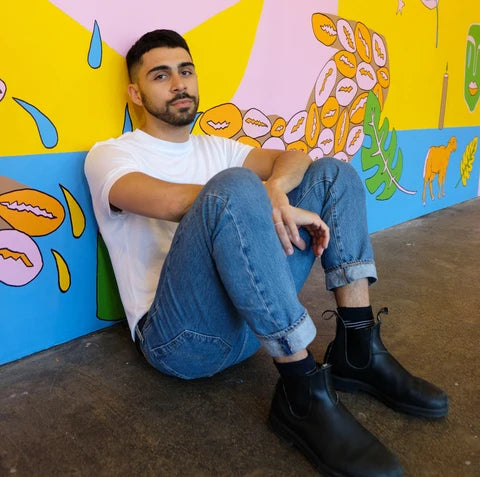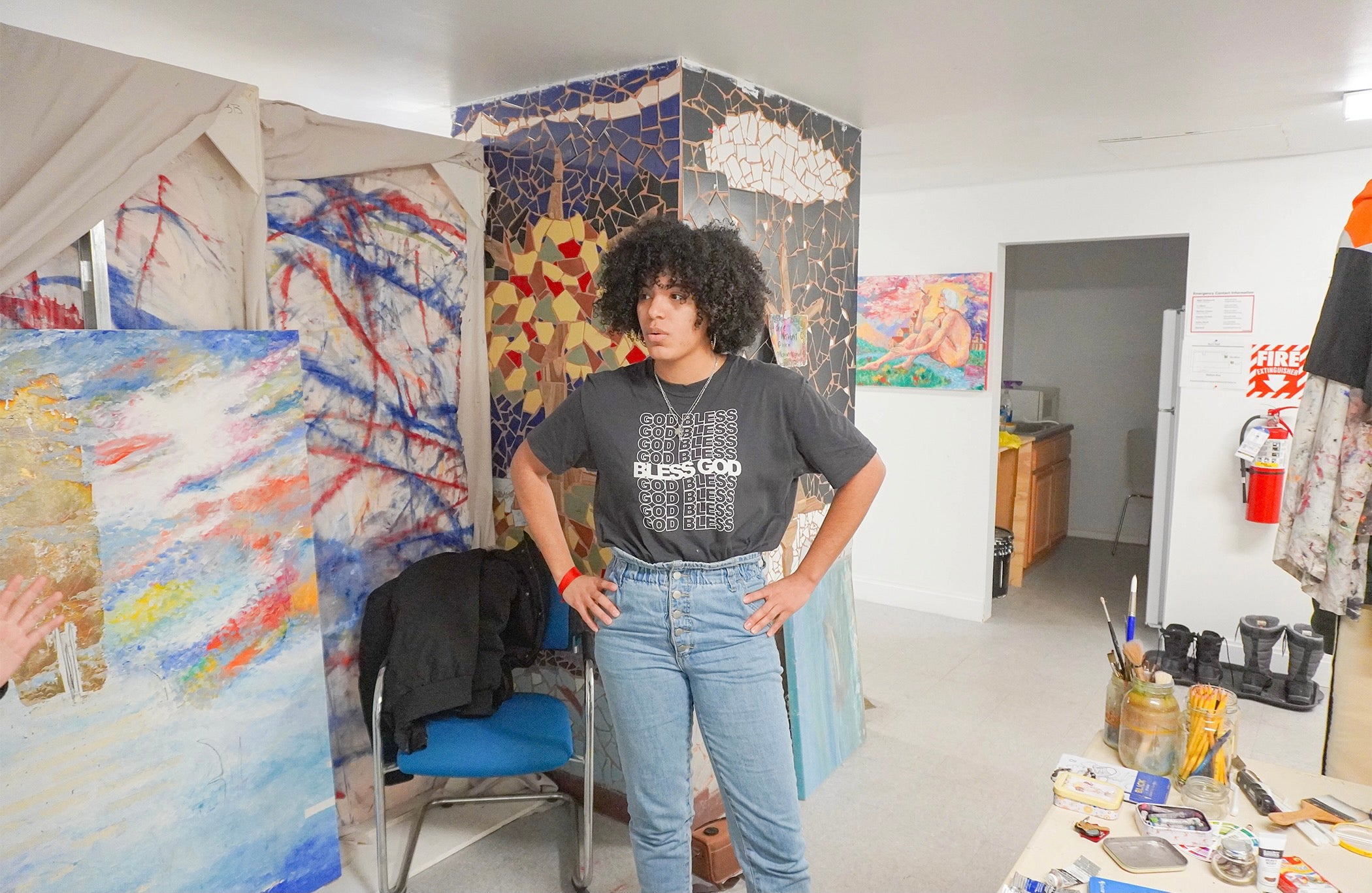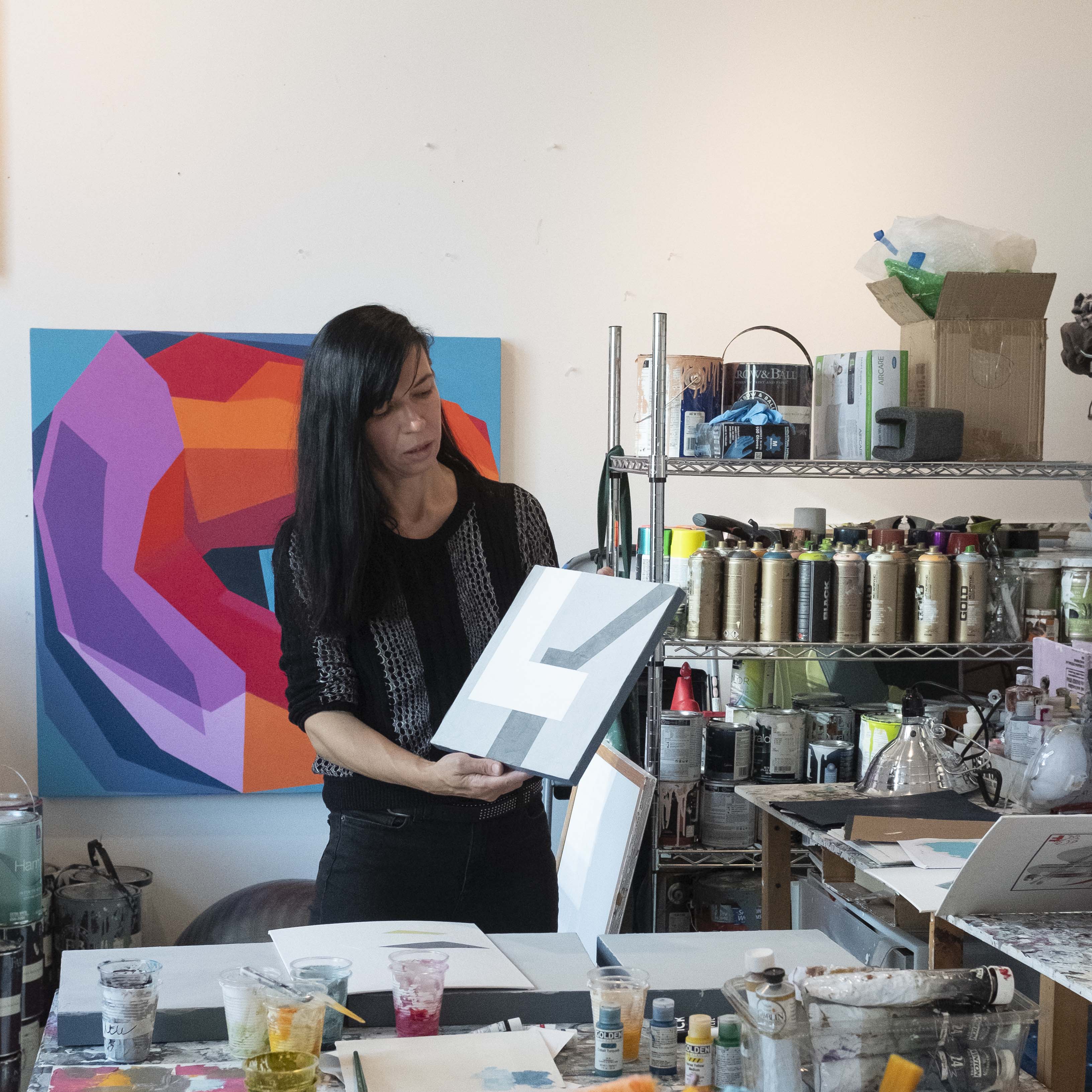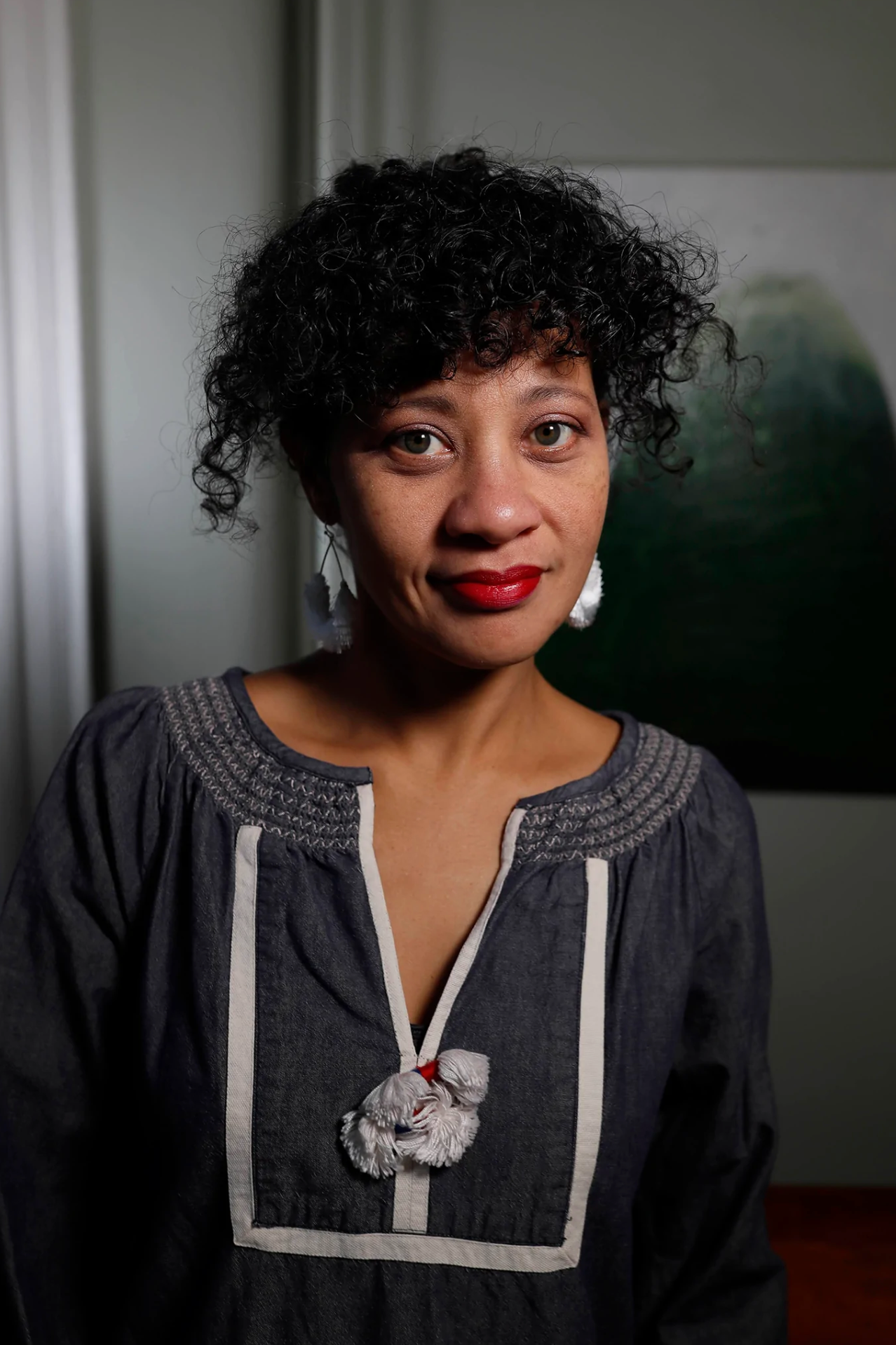No Products in the Cart
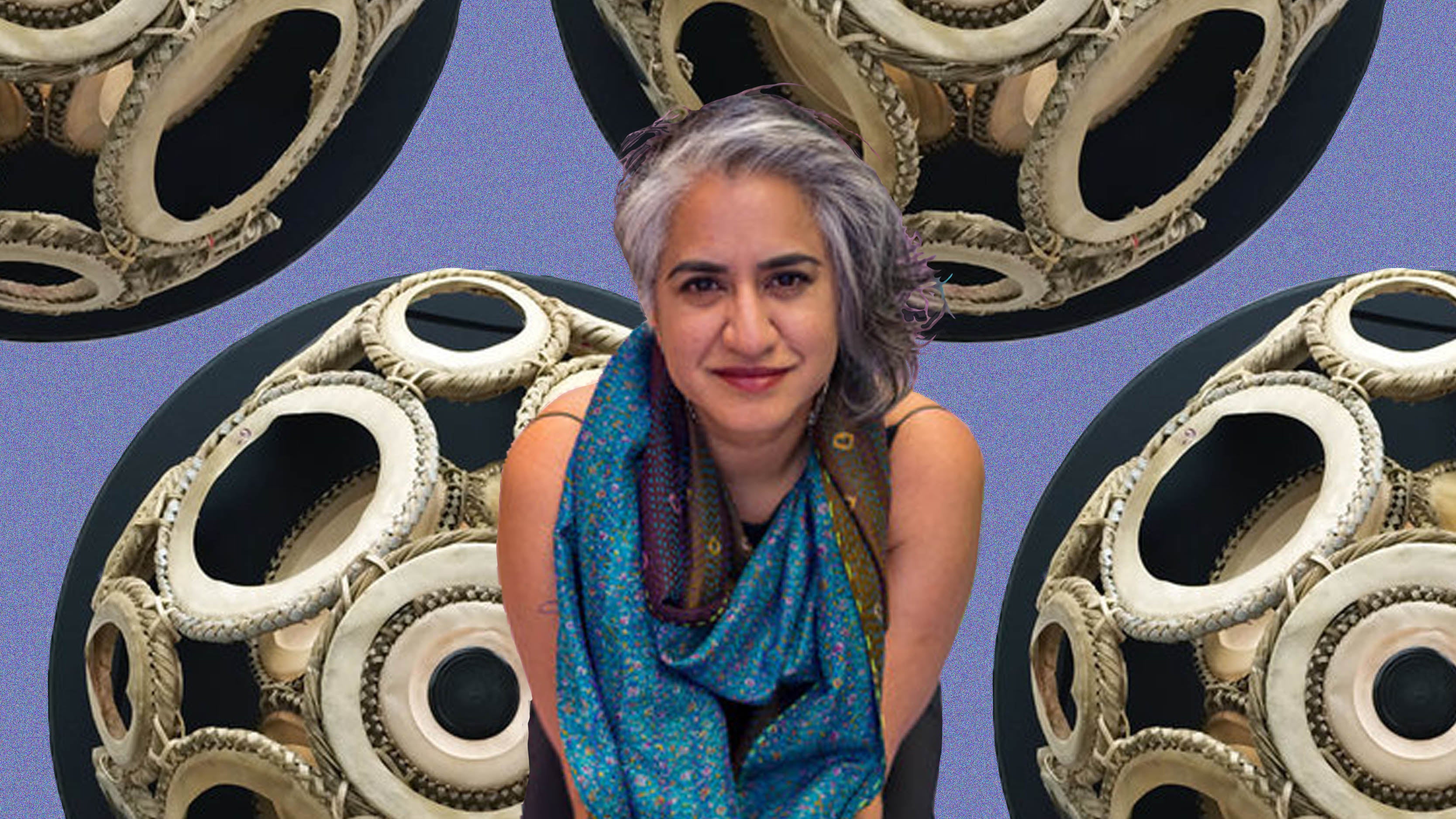
Guest Curator Seema Lisa Pandya talks Sustainability in the Arts
Seema Lisa Pandya is a Brooklyn based multidisciplinary artist and accomplished sustainability consultant who explores the intersection between sustainability, art, culture, and the built-environment with an aim of connecting audiences with an experiential awareness of nature and primordial forms. Her work ranges from fine art, public art, painting, photography, wood-working, light sculptures, kinetic interactive sculptures; as well as, sustainability consulting, green building certification coordination, and building integrated installations.
Look at the art in the background! It’s already foreshadowing a lot of things we’re going to talk about. Are you in your studio?
This is my home and my studio!
Could you briefly introduce yourself and what you do?
I am a visual artist but I wear lots of hats. I do sculpture, some painting, public art, and I also teach at the New York School of Interior Design for the Master’s program for Sustainable Interior Environments. I also often teach green building as an adjunct as FIT. I also work as a consultant for architecture and design firms on green building projects from design all the way to construction. All of that gets influenced into my visual works.
I always love to see visual artists with footing in many different fields!
There’s also the fact that, growing up with South Asian parents, they would always say “art is great but choose something more financially viable” *laughs*. So I sort of took that to heart and pursued several careers, but always had art on the sideline. In the last several years, visual art has been moving more into the main line career.
That leads nicely to my first question. Between the allegedly “practical” discipline of building and design and more fine arts pieces; and even within fine arts, between public art and small sculptures, do each of those different mediums make you think of sustainability in a different way?
While you should always be taking context into account, with public art pieces I think you should take it even further. It’s being engaged with in people’s everyday life as they take a walk, as they go to the park...so it’s more intertwined into the fabric of life. It makes me think more of the audience. It’s not just thinking about, but entering a sort of dialogue with them thinking about what the limitations and opportunities are.
Seema Lisa Pandya, Amoebic Bench (2020), Brockport College
I’ll give you a perfect example - my most recent public art piece was a wooden bench that I designed as a parametric model. It was installed at Brockport College in upstate new york. Now, the wood itself has a history as it came from the college from tree that had to be removed so they could build a new building. There was the opportunity to reclaim and repurpose this wood. Also it is to be used by people on the campus. Contrary to galleries usually directing people “don’t touch”, you have to expect that people are going to be sitting on it, crawling on it, licking it.
Are there pieces where audiences are made aware that the actual materials of your works themselves are recycled?
This piece behind me is one of my sculptures from the Tabla Tapestry series. Tabla is a traditional percussive instrument from India that I also learned to play. These are actually the heads of the drums, not only are they reclaimed, but every single one of these heads have had percussionists putting thousands of hours of rhythmic energy and touch on them. It’s a special material because it is embodied with physical touch from musicians. So, in this series I’m really playing on what I see as the push and pull of waves - including sound - as an undulating balance between two things.
You state that “sustainability and art are personally transformative.” In a similar way to how you say material history comes forth in Tabla Tapestry, is there other work you have done to push back against being an “all-powerful author” when it comes to creating artworks?
One of my earliest installation pieces was when I lived in Denver, CO. I was running and curating a gallery called Revoluciones Collective Art Space. It was a series of two panels where I etched in a poem on both sides. The first one was an allegory on how god was trying to create some “thing” and creates a point. But a point is not anything. If you join points together you make a line. Lines together form letters etc...but none of them are real things, they are just impressions of things without depth or height or mass. In the end, the all-powerful being blows the breath of life past words and creates humans. The idea behind this is that as the audience looks at the first panel that is clear plexiglass with floating letters, you would see the next person before the second panel. It’s interactive in that the audience member becomes a visual element of the artwork itself, as important as any other brushstroke. And hopefully, when they move to the second panel, they will get the feeling that they are then being looked at by the previous person in the audience. I was using people’s interaction as a design element.
You both teach and work in the sustainable building field. What are the main differences between how sustainable design is taught and how it is actually implemented?
I think this goes for many different design professions - sometimes your ideas get sidelined. You’re told: “I know that’s a great sustainable material, but we’re more comfortable with vinyl”...because it’s cheaper.. It speaks a lot to consumer culture and the nature of Capitalism in general. Faster and cheaper. Whereas, sustainability encourages that you take your time to make the right decisions, then it can be cheaper in the long run.
Have you seen examples of sustainability being limited or inflected by social categories like socioeconomic classes or ethnicity?
You can’t promote sustainability without looking at how it affects different communities. It’s all linked to capitalism and all intertwined. The way we used to do “sustainable building” as a society was to build regular smart buildings. We used to look at the position of the sun, then make south-facing windows to let in more light and heat passively, or block the sunlight as needed; we used to be much more informed and intune with local conditions, seasonal changes, and with local building materials. When you look at the history of building in all different cultures, or what is known as vernacular design, most of these buildings respond very directly to their climate, what materials are available and other constraints - the architecture stands the test of time. An example is in the hot climate of the Middle East and Mediterranean where you see a lot of white stucco that not only looks beautiful but it is a readily available local material that also reflects the heat because of the light color.

Vernacular architecture by Yatin Pandya
My uncle, Yatin Pandya, is a very well known architect in India that I studied with and have been influenced by. He deals very directly with sustainability and how it intertwines into culture. He designed a culture and activity center for a slum in India. The people there historically have made money by collecting waste, sorting it, and reselling it. The idea wasn’t to “elevate the poor people into something different entirely” but to celebrate the existing culture. The center was built in a way intertwined in and out with the neighborhood by using recycled glass, bottles, discarded CDs etc.
These examples tell us that inclusive projects are possible on a budget if we’re working with [local] people to show us how to reflect preserve culture with dignity.
Do you have any specific sustainability tips for visual artists (we’re compiling tips from artists and ourselves in this doc)?
We can think about that in two different aspects. First of all, from the gallery and studio perspective.
Lighting will be the biggest energy load. Incandescent lighting looks nice, but is horribly ineffective using a lot of energy to produce light and does not have a long life before needing to be tossed out. LEDs go a long way, almost 25 years before having to be discarded, and only takes ⅛ of the energy. So invest in LED lighting which may cost more upfront, but the payback over time will be high and there are ever evolving full spectrum options available.
And gallery owners use a lot of paint. Sustainability is not just about energy but about human health, so choose paint that will not emit gas. Low VOC or no VOC paints are going to help air quality not only for people who maintain the space but also for visitors.
Utilizing as much daylight as possible, as long as you put UV film to not damage the work, can be beneficial for establishments. There’s a philosophy called biophilia - that humans are biologically inclined to be more attracted to nature. To have more artwork under natural light will have audience members more drawn to them.
I also think art organizations like Chashama have a great model. They don’t have permanent gallery spaces, but use temporary retail locations, so instead of taking up more square footage with new plumbing, electricity, and everything after demolishing what was already there, they are using spaces that are already there yet underutilized.
For artists, it’s important to think about the toxicity about the materials you’re using, which I could go on about for several more hours!! We can make that a whole other talk. Basically, think about the toxicity of how the material was made, maintained, exposure as you use it, and are there toxins that enter the environment if discarded? It’s important to think of the whole life cycle.
In your example, the materials you use, like repurposed wood, requires some training specific to the material, right? What are some resources artists can start teaching themselves how to use?
In New York, Makerspace is a co-op model where you join to take classes and use their equipment or materials. I myself have a mini workshop in my house, a garage that I turned into a woodshop.
Makerspace New York
For larger public art, a lot of artists don’t often make it themselves. They are often working with craftspeople and relying on them for material expertise and the actual fabrication. If I start working with materials I’m not familiar with or start making really big pieces, I will probably get help from those artisans for fabrication. For the most part until now I’ve been preferring wood precisely because I know how to use it, I can teach myself as I need to do new things, and there is so much to be reused.
What are good places to scavenge at?
You can find it anywhere and everywhere! Look for dumpsters, especially construction dumpsters, because their stuff is already sorted.
I find that often after I pick up things I find on the street, I would put it aside, and later those materials will speak to me. That way it changes the design process too. It’s not always that I have an idea and force my will onto the materials, but I think about what I have available first.









